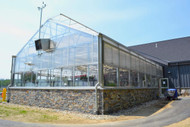Tucked on the western edge of New Hampshire, nestled among lakes and rolling hills, lies the town of Newport, NH. While Newport may be small on the map, it holds something special: the Sugar River Valley Regional Technical Center, a career and technical education school that serves the Newport School District as well as neighboring Claremont and Sunapee School Districts.
At Sugar River Valley, students have the opportunity to participate in classes and programs designed to prepare them for secondary education or a technical career path. One such program is Animal & Plant Sciences, led by 25-year educator Deb Stevens. The program explores a diverse range of topics including animal welfare, plant propagation, greenhouse management, and even sales and marketing for the agricultural industry.

“Every student that walks through these doors has a different story,” Deb shared. “I never teach a chapter from a book – I look at what do my kids need, where are they going, what do they love?”
“A lot of kids that come to our program don’t know that they love plants, or that they love companion animals,” she added. “Once they’re here and they’re immersed in it, it allows them to see their own potential.”
A State-of-the-Art Greenhouse
Sugar River Valley recently completed a $15 million renovation of their Career & Technical Education (CTE) building, funded in part by the federal Perkins Grant program. As part of the renovation, the school was able to build a brand new, state-of-the-art greenhouse to support the Animal & Plant Sciences program.

The greenhouse is a 30’ x 48’ Rimol Matterhorn, attached directly to the main CTE building. The greenhouse is outfitted with a variety of accessories to support optimal growing conditions, including a Reznor heater, fans and shutters, a ridge vent and side wall vents, and insect screening. The greenhouse’s shade system, custom lighting system and heating and cooling systems are all integrated and centrally managed by a Wadsworth Seed controller. Sugar River Valley also purchased greenhouse benches from Rimol to complete their setup.
“When we were looking at this renovation, the biggest thing that I asked for was flexibility of space,” said Deb. “I wanted to be able to move benches, have flexibility for seasons and community events. When this started to come to fruition with this building and a greenhouse attached, we saw that we would be able to have that, and it’s proved itself already.”
From Watering to Tissue Culture: Hands-On Lessons in Plant Care
Students in the Animal & Plant Sciences program are working hands-on in the greenhouse daily. Depending on the class, lessons may cover topics such as the fundamentals of plant care, or more advanced topics such as plant tissue culture.
“Kids need to know how to grow things,” said Deb. “What we teach here are the basics – what does it look like when there’s a nutritional deficiency in my basil? If they’ve never seen it, if they’ve never experienced it, they wouldn’t know.”

She added, “I have students all over the country now who are florists, they’re running landscape companies in Boston, they’re doing vet tech, all kinds of things. And they may go into this, but they may have their own garden. We teach them how to can, how to pickle, how to blanche and freeze. Even though you don’t see them every day, they’re taking the lessons with them.”
“I tell kids, any ag career is connected. Somehow it connects back to the earth, to growing, to horticulture. You don’t have to be farming to be part of agriculture and horticulture.”
Supporting Intra-Curricular Involvement Through FFA
A core component of Sugar River Valley’s CTE program is organizational involvement at an intra-curricular level. For the Animal & Plant Sciences program, the student organization is the Future Farmers of America (FFA). This year, two teams from Sugar River Valley will be attending the National FFA Convention in Indianapolis after qualifying for the national competitions in environmental and natural resources and floriculture.
“I was probably teaching just a couple of years when I went to my first National Convention, and when I did and I saw that sea of blue, I was all in,” said Deb. “There was something that connected these students that you can’t even put into words.”
“It opens doors for kids,” she added. “They just see themselves in little Newport, New Hampshire, but you take them to a leadership conference, you take them to different state contests, and all of the sudden their world starts to open. Suddenly, they can see there is a potential to do something that nobody in their family had ever done.”
Fostering Community Connections
In addition to the work that the students do in the greenhouse, they also use their acquired skills to give back to the local community through various events and service outreach. For example, during COVID, students put together packets of donated seeds for anyone interested to pick up and use in their gardens. Deb also hosts adult classes and workshops in the greenhouse, teaching topics such as pruning and floral design.

“We have really made a connection within our community,” said Deb. “We had a few different events through the winter, but our Mother’s Day plant sale was the first time everybody came out, and people loved the greenhouse.”
“The idea is to give students and to give a community an educational space. That was my dream — to have this become something that a whole new generation can experience and learn from.”

